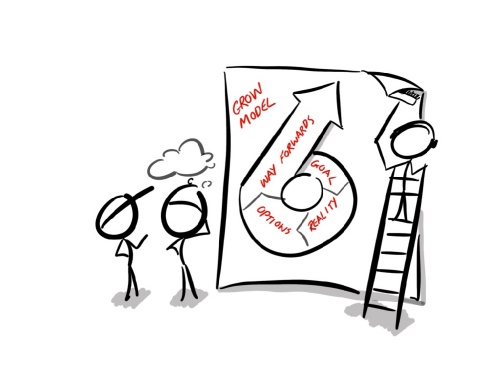GROW Model
The Grow Model is a goal based model with several stages that has several contributors and is described in Max Landsberg's book The Tao of Coaching The model is similar to the Inner Game method used by Timothy Gallwey for peak performance tennis coaching.
Goal
At this stage, the coachee describes the goal, target or desired end state to be achieved. This may be "to be a great team facilitator" for example.
Reality
In this stage, the coach and coachee evaluate the current reality, the current situation, the challenges and how far away they are from their intended goal. This may take the form of a candid conversation or some activity with evidence or metrics to inform the current situation.
In the example, the coachee may facilitate a group event such as a Sprint Retrospective that can be evaluated and decomposed with the coach afterwards, who might ask searching questions such as "Why did you do things that way?" and "What would you do differently next time?"
Options / Obstacles / Opportunities
During this stage the coach and coachee discuss the possibilities and potential obstacles towards attaining their goal. This may be in the form of awareness raising questions using Socratic Questioning techniques for example to encourage the coachee to discover their own capabilities, what they are achievable of and how they might achieve their goal. Obstacles may also be identified and the coachee is encouraged to determine how they can overcome these challenges.
In the example, the coachee is encouraged to determine their own path and may be prompted by the coach with questions such as "What's holding you back?" or "What alternatives could you do next time?"
Way Forwards
Once the coachee has identified methods and approaches to overcome the challenges and discover a pathway to attain their goal, then these can be distilled as actions in an action plan which constitutes a Way Forwards for the coachee to attain their desired goal or end state.
The action plan should be defined by the coachee and positioned as "their plan" to ensure that it is something appropriate, sustainable and is owned by the coachee who has the responsibility to follow or adjust it.
Hints and Tips
Evidential based decision making can be quite sobering and is a good approach, if appropriate, to help inform the current reality and provide critical evaluation of a coachee's capabilities.
This technique may be appropriate in combination with some activity that is linked to the goal that can be evaluated and provide more insights into how to achieve the goal.
Not Quite Going To Plan
A clear and discrete goal may be more attainable than a broad and ambiguous goal, and so goals should be fairly narrow and achievable. Avoid being too theoretical with this approach, where an experience based approach couple with observation and theory work best to improve the peak performance.
